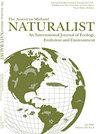一夫多妻制和一夫一妻制哺乳动物种群中成年性别比的比较分析
IF 0.6
4区 环境科学与生态学
Q4 Agricultural and Biological Sciences
引用次数: 1
摘要
摘要由于性别之间的生活史差异,在一些一夫多妻制哺乳动物种群中,丰度与成年性别比(ASR,雄性:雌性)之间存在相反的密度依赖关系。雄性的繁殖力和生存能力取决于试图获得尽可能多的交配,而雌性的繁殖能力和生存能力则取决于资源的获取。因此,由于种间争夺,雌性通常先于雄性获得饲料,特别是当饲料的K承载能力变得更加有限时。这导致特定地区的男性被动流离失所。人们普遍认为,大多数一夫一妻制哺乳动物种群都表现出均衡的成年性别比例。种群中性成熟的雄性和雌性的结合导致了这种交配系统的这种模式。目前的文献集中在哺乳动物的初级或次级性别比或单个物种的ASR模式上。我们的目标是测试预期的ASR模式是否在两个交配系统中的许多物种中都可见。我们假设,在一夫多妻制种群中,丰度和ASR之间存在反比关系,而在一夫一妻制种群中丰度和ASR没有关系。我们从已发表的文献中提取了15种不同哺乳动物的43个种群的时间序列种群数据。我们对线性混合效应模型的分析结果与我们对一夫多妻种群的假设一致,因为我们发现丰度和ASR之间存在显著的反比关系。然而,我们的分析也揭示了一夫一妻制人群中丰度和ASR之间的显著反比关系,这与我们的假设不一致。我们的发现为一个理论模型提供了定量支持,该模型解释了驱动一夫多妻哺乳动物丰度和ASR之间密度依赖关系的进化和生态机制。需要对一夫一妻制哺乳动物进行调查,以评估为什么一些具有这种交配系统的物种在ASR中也表现出密度依赖性反应。本文章由计算机程序翻译,如有差异,请以英文原文为准。
A Comparative Analysis of Adult Sex Ratios in Polygynous and Monogamous Mammal Populations
Abstract. An inverse density-dependent relationship between abundance and adult sex ratio (ASR, males:female) occurs in some populations of polygynous mammals due to life history differences between the sexes. Male fecundity and survival is dictated by attempts to obtain as many copulations as possible, whereas female fecundity and survival is dictated by resource acquisition. Therefore, females usually acquire forage before males as a result of interspecific scramble competition, particularly when forage becomes more limited at K carrying capacity. This leads to the passive displacement of males in a given area. The common belief is that most monogamous mammal populations exhibit balanced adult sex ratios. The coupling of sexually mature males and females in a population result in this pattern for this mating system. Present literature focuses on primary or secondary sex ratios in mammals or on ASR patterns within individual species. Our goal was to test if expected ASR patterns would be visible across numerous species in both mating systems. We hypothesized we would see an inverse relationship between abundance and ASR across polygynous populations, and no relationship between abundance and ASR across monogamous populations. We extracted time series population data from published literature for 43 populations of 15 different mammal species. Results from our analysis of a linear mixed-effects model were consistent with our hypothesis for polygynous populations, as we found a significant inverse relationship between abundance and ASR. However, our analysis also revealed a significant inverse relationship between abundance and ASR in monogamous populations that was not consistent with our hypothesis. Our findings provide quantitative support for a theoretical model explaining the evolutionary and ecological mechanisms driving a density-dependent relationship between abundance and ASR in polygynous mammals. An investigation into monogamous mammals is needed to assess why some species with this mating system display a density-dependent response in ASR as well.
求助全文
通过发布文献求助,成功后即可免费获取论文全文。
去求助
来源期刊

American Midland Naturalist
环境科学-生态学
CiteScore
1.20
自引率
0.00%
发文量
38
审稿时长
18-36 weeks
期刊介绍:
The American Midland Naturalist has been published for 90 years by the University of Notre Dame. The connotations of Midland and Naturalist have broadened and its geographic coverage now includes North America with occasional articles from other continents. The old image of naturalist has changed and the journal publishes what Charles Elton aptly termed "scientific natural history" including field and experimental biology. Its significance and breadth of coverage are evident in that the American Midland Naturalist is among the most frequently cited journals in publications on ecology, mammalogy, herpetology, ornithology, ichthyology, parasitology, aquatic and invertebrate biology and other biological disciplines.
 求助内容:
求助内容: 应助结果提醒方式:
应助结果提醒方式:


